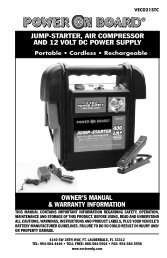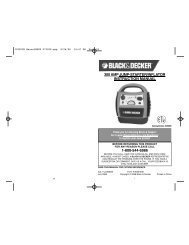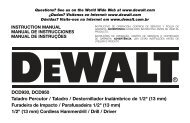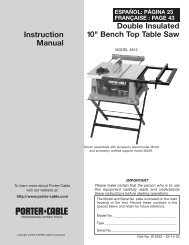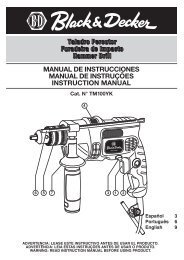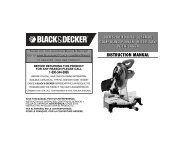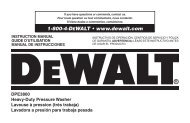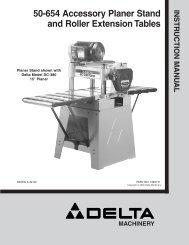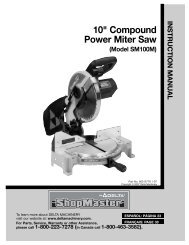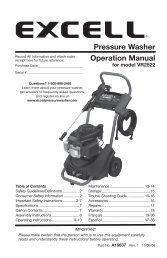4 IN. x 8 IN. (102 MM x 203 MM) BELT / DISC SANDER PONCEUSE ...
4 IN. x 8 IN. (102 MM x 203 MM) BELT / DISC SANDER PONCEUSE ...
4 IN. x 8 IN. (102 MM x 203 MM) BELT / DISC SANDER PONCEUSE ...
Create successful ePaper yourself
Turn your PDF publications into a flip-book with our unique Google optimized e-Paper software.
!<br />
!<br />
DANGER<br />
CAUTION<br />
SAFETY GUIDEL<strong>IN</strong>ES - DEF<strong>IN</strong>ITIONS<br />
WARN<strong>IN</strong>G ICONS<br />
Your power tool and its Instruction Manual may contain “WARN<strong>IN</strong>G ICONS” (a picture symbol intended to alert<br />
you to, and/or instruct you how to avoid, a potentially hazardous condition). Understanding and heeding these<br />
symbols will help you operate your tool better and safer. Shown below are some of the symbols you may see.<br />
!<br />
SAFETY ALERT: Precautions that involve your safety.<br />
PROHIBITION<br />
WEAR EYE PROTECTION: Always wear safety goggles or safety glasses with side shields.<br />
READ AND UNDERSTAND <strong>IN</strong>STRUCTION MANUAL: To reduce the risk of injury, user and all bystanders<br />
must read and understand instruction manual before using this product.<br />
KEEP HANDS AWAY FROM BLADE: Failure to keep your hands away from the blade will result in serious<br />
personal injury.<br />
WARN<strong>IN</strong>G<br />
CAUTION<br />
SUPPORT AND CLAMP WORK<br />
DANGER: Indicates an imminently hazardous situation which, if not avoided, will result in<br />
death or serious injury.<br />
WARN<strong>IN</strong>G: Indicates a potentially hazardous situation which, if not avoided, could result in<br />
death or serious injury.<br />
CAUTION: Indicates a potentially hazardous situation which, if not avoided, may result in minor<br />
or moderate injury.<br />
CAUTION: Used without the safety alert symbol indicates a potentially hazardous situation<br />
which, if not avoided, may result in property damage.<br />
SAND<strong>IN</strong>G LEAD BASED PA<strong>IN</strong>T:<br />
Sanding of lead based paint is NOT RECO<strong>MM</strong>ENDED due to the difficulty of controlling the contaminated dust. The<br />
greatest danger of lead poisoning is to children and pregnant women. Since it is difficult to identify whether or not a<br />
paint contains lead without a chemical analysis, we recommend the following precautions when sanding any paint:<br />
PERSONAL SAFETY:<br />
● No children or pregnant women should enter the work area where the paint sanding is being done until all clean up<br />
is completed.<br />
● A dust mask or respirator should be worn by all persons entering the work area. The filter should be replaced daily<br />
or whenever the wearer has difficulty breathing.<br />
NOTE: Only those dust masks suitable for working with lead paint dust and fumes should be used. Ordinary painting<br />
masks do not offer this protection. See your local hardware dealer for the proper (NIOSH approved) mask.<br />
● NO EAT<strong>IN</strong>G, DR<strong>IN</strong>K<strong>IN</strong>G or SMOK<strong>IN</strong>G should be done in the work area to prevent ingesting contaminated paint<br />
particles. Workers should wash and clean up BEFORE eating, drinking or smoking. Articles of food, drink, or<br />
smoking should not be left in the work area where dust would settle on them.<br />
ENVIRONMENTAL SAFETY:<br />
● Paint should be removed in such a manner as to minimize the amount of dust generated.<br />
● Areas where paint removal is occurring should be sealed with plastic sheeting of 4 mils thickness.<br />
● Sanding should be done in a manner to reduce tracking of paint dust outside the work area.<br />
CLEAN<strong>IN</strong>G AND DISPOSAL:<br />
● All surfaces in the work area should be vacuumed and thoroughly cleaned daily for the duration of the sanding<br />
project. Vacuum filter bags should be changed frequently.<br />
● Plastic drop cloths should be gathered up and disposed of along with any dust chips or other removal debris. They<br />
should be placed in sealed refuse receptacles and disposed of through regular trash pick-up procedures. During<br />
clean up, children and pregnant women should be kept away from the immediate work area.<br />
● All toys, washable furniture and utensils used by children should be washed thoroughly before being used again.<br />
3



